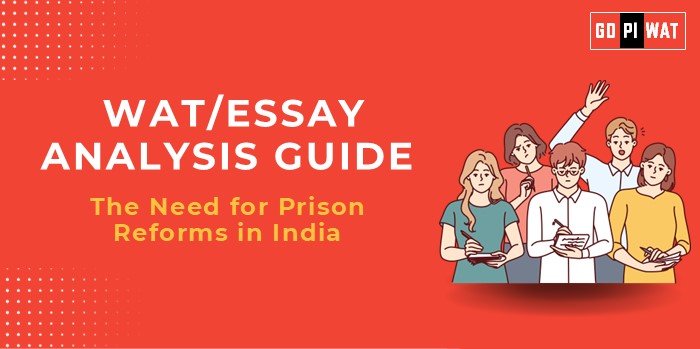📋 Written Ability Test (WAT) Analysis Guide: The Need for Prison Reforms in India
🌐 Understanding the Topic’s Importance
India’s prison reform debate is integral to discussions on human rights, governance, and systemic efficiency. The topic ties to public policy, societal justice, and ethics, making it highly relevant for B-school essays.
⏳ Effective Planning and Writing
- Time Allocation:
- 📝 Brainstorming: 5 minutes
- ✍️ Writing: 20 minutes
- 🔍 Review: 5 minutes
- Preparation Tips:
- 📊 Note key statistics like occupancy rates (130%) and under-trial population (76%).
- 📘 Highlight stakeholder roles, systemic deficiencies, and existing reforms.
💡 Introduction Techniques for Essays
-
- Contrast Approach:
“While Norway prioritizes rehabilitation and boasts a recidivism rate below 20%, Indian prisons face severe overcrowding with 76% under-trials, demanding urgent reforms.”
-
- Problem-Solution Approach:
“India’s colonial-era prison system, marked by 130% occupancy rates, calls for systemic reforms to ensure justice and humane treatment.”
📖 Structuring the Essay Body
- Achievements:
- ✅ Implementation of open prisons in select states, promoting rehabilitation.
- 📘 Skill development initiatives aimed at reducing recidivism.
- Challenges:
- ⚠️ Severe overcrowding with limited infrastructure.
- 🚑 Lack of medical care and custodial violence concerns.
- ⏳ Judicial delays leading to prolonged under-trial incarceration.
- Future Outlook:
- 🤖 Integration of technology for monitoring and management.
- 🌍 Global benchmarking to adopt progressive policies like those in Norway.
- 📜 Modernization of colonial-era policies to align with human rights standards.
📄 Concluding Effectively
-
- Balanced Perspective:
“Prison reforms offer a path toward a just and humane society, provided resource allocation and societal support align with policy changes.”
-
- Solution-Oriented Approach:
“With phased investments in technology, legal reviews, and rehabilitation programs, India can transition toward a fair and efficient prison system.”
📊 Analyzing Successes and Shortcomings
- Key Achievements:
- ✅ Implementation of open prisons in states like Rajasthan.
- ⚖️ Judicial interventions promoting accountability and transparency.
- Ongoing Challenges:
- 🏗️ Severe overcrowding with infrastructure inadequacies.
- 📉 Limited budget allocation and funding gaps.
- Global Context: Learn from Norway’s rehabilitation model and Singapore’s efficient systems.
🚀 Recommendations for Sustainable Progress
- 📘 Expand open prison models to promote rehabilitation and reintegration.
- 💰 Increase budget allocation for improving prison infrastructure.
- ⚖️ Enhance judicial efficiency to reduce the under-trial population.
✍️ Sample Short Essays
-
- Balanced Perspective:
“India’s prison system, shaped by colonial-era laws, struggles with overcrowding and judicial delays. With 76% of inmates as under-trials, systemic reforms that prioritize rehabilitation and humane treatment are essential.”
-
- Solution-Oriented:
“To address India’s prison crisis, a focus on open prisons, skill development programs, and judicial efficiency is vital. These steps can reduce overcrowding and promote societal reintegration.”
-
- Global Comparison:
“Norway’s rehabilitation-centric prison system provides a roadmap for India to address its 130% occupancy rate and ensure human rights compliance.”


